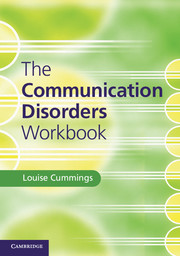Book contents
- Frontmatter
- Contents
- Preface
- Acknowledgements
- List of data analysis exercises
- Chapter 1 Introduction to communication disorders
- Chapter 2 Developmental speech disorders
- Chapter 3 Developmental language disorders
- Chapter 4 Communication disorders in mental illness
- Chapter 5 Acquired speech disorders
- Chapter 6 Acquired language disorders
- Chapter 7 Disorders of voice
- Chapter 8 Disorders of fluency
- Chapter 9 Hearing disorders
- Answers to questions and exercises
- Glossary
- References
- Index
- References
Chapter 9 - Hearing disorders
Published online by Cambridge University Press: 05 June 2014
- Frontmatter
- Contents
- Preface
- Acknowledgements
- List of data analysis exercises
- Chapter 1 Introduction to communication disorders
- Chapter 2 Developmental speech disorders
- Chapter 3 Developmental language disorders
- Chapter 4 Communication disorders in mental illness
- Chapter 5 Acquired speech disorders
- Chapter 6 Acquired language disorders
- Chapter 7 Disorders of voice
- Chapter 8 Disorders of fluency
- Chapter 9 Hearing disorders
- Answers to questions and exercises
- Glossary
- References
- Index
- References
Summary
Hearing disorders can result from damage to the ear, the auditory pathways to the brain and the auditory cortices of the brain. Depending on the location of this damage, a child or adult may be said to have a conductive or sensorineural hearing loss. If there is damage to the outer or middle ear, a conductive hearing loss is often the result. For example, the ear canal or external auditory meatus may fail to develop normally during embryological development in conditions such as Treacher Collins syndrome. A severe conductive hearing loss occurs when there is complete atresia of the ear canal. Alternatively, the palatal abnormalities of the child with a cleft palate may compromise the opening of the Eustachian tube, leading to reduced ventilation of the middle ear. (The contraction of the tensor veli palatini muscle causes this tube to open.) This can lead to the development of otitis media (‘glue ear’) in which a conductive hearing loss arises from impaired mechanical vibration of the ossicular chain in the middle ear. This disorder can be treated by means of the insertion of a pressure equalizing tube into the tympanic membrane in a surgical procedure known as a myringotomy. In another middle ear disorder known as otosclerosis, new bone growth on the anterior footplate of the stapes (the third bone in the ossicular chain) can cause a conductive hearing loss of up to 50 dB (Ackley, 2014).
Even when the conduction of sound waves through the external and middle ear is successfully achieved, a range of inner ear problems can impede normal hearing. For example, hair cells in the cochlea may be damaged as a result of infections such as meningitis. Also, the stereocilia of these cells may become fractured following sustained noise exposure. In both cases, the generation of nervous impulses from the inner ear along the auditory pathway to the brain will be compromised. Parts of this pathway may also be damaged as a result of infections, trauma or cerebrovascular accidents. The auditory cortices which receive nervous signals from the inner ear may be impaired following a head trauma or cerebrovascular accident. In each of these scenarios, the child or adult will experience a sensorineural hearing loss which may be partial or complete. Where a sensorineural hearing loss is related to cochlear damage, treatment may involve cochlea implantation. In the assessment and treatment of hearing disorders, speech and language therapists must work closely with audiologists and ENT specialists (otolaryngologists) as part of a multidisciplinary team.
- Type
- Chapter
- Information
- The Communication Disorders Workbook , pp. 136 - 155Publisher: Cambridge University PressPrint publication year: 2014



